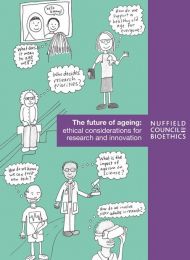The future of ageing
Report
Published 25/04/2023

This report sets out an ethical framework and recommendations for research and innovation related to ageing.
How we think about ageing
Conceptions of ageing
The way in which we (including researchers, policymakers of all kinds, the media, and the general public) think and talk about ageing plays an important role in shaping the research agenda. Beliefs and attitudes about ageing help define the questions to which research and innovation seek to offer solutions. Current debates (discussed further in our background paper) include:
- the balance between seeing biological and chronological ageing primarily in terms of deficits and loss, or in terms of opportunities and prospects for ongoing social contribution (e.g., as in the ‘capabilities’ approach to ageing);
- the extent to which biological ageing is understood to be malleable – recognising the scope for a person’s current health trajectory to change, whether through existing well-understood social and public health measures, or through biomedical innovation; and
- the influence of ageism, and what can be/is being done to challenge ageist attitudes.
The experience over the last year of the COVID-19 pandemic has shone a spotlight on how assumptions about older people directly affect policy – for example in terms of their assumed vulnerability and inability to make personal choices about risk, or in terms of age-related thresholds for access to certain forms of care. It has also highlighted how the interests of different parts of the population (for example older people vs school children) can at times be in tension – an issue to which we return in section 6 of this call for evidence.
Question 1
Please comment on how attitudes to ageing influence research and innovation – and how more positive attitudes to ageing could be promoted within the research and innovation context.
Issues you might wish to touch on in your response include (but are not limited to):
- whether there is a common view of what ‘old age’ is, or what the key features of ‘old age’ are, in your field or area of work – and how this influences your work;
- the connections / distinctions between ageing, disease, and disability – and how these affect approaches to research and innovation;
- whether there are common barriers or limitations in your field due to ageism;
- specific examples of effective approaches to combating ageism – whether in research / innovation, or more broadly in policy and service provision;
- how negative stereotypes of ageing and old age in research and technological innovation (for example those that focus solely on deficits) can be challenged.
Ageing as a special case?
Ageing is often seen as separate, even ‘deviant’, from a healthy norm – in policy, in research, and even in ethics. This is exemplified by the way that services and design for older people are often treated as a special case rather than as part of the mainstream. This may arise because of neglect (with mainstream policy focused on the needs of healthy, able, adult populations), or it may be with the intention of providing more specialised services (for example in the specialty of geriatrics / elderly care). In the case of products specifically targeting older populations, one criticism has been that they are too often “big, beige and boring” – and that as a result older people are put off using products and devices that could in fact be helpful in their daily lives.
There is increasing emphasis by leading organisations concerned with ageing such as the Centre for Ageing Better on the importance of seeking inclusive approaches to wider social policy: designing the needs of older people ‘into’ generic design and policy, rather than thinking about older people’s needs as an afterthought.
One example of treating ageing as a special case is found in the current proposal for a special UN Convention on the rights of older people. The aim of those putting forward this proposal is to ensure that the rights of older people are not overlooked – especially when they are relatively invisible to wider society. They hope that it would trigger legal and social changes that would lead to better access to services, and prevent the needs and preferences of older people being ignored. The proposed use of a separate convention has, however, also generated concerns, including whether it is ethical to consider the rights of older people separately from those of other adults.
Question 2
Please comment on the advantages and disadvantages of taking a more inclusive approach (e.g., in design, in healthcare, in wider social policy) so that the needs of older people are ‘designed in’ to mainstream approaches, rather than considered separately.
Issues you might wish to touch on in your response include (but are not limited to):
- examples of existing good practice where social policy (e.g., in housing, transport, employment, healthcare, or digital infrastructure to enable connectedness) has taken an inclusive approach to older people’s needs – and any advantages / disadvantages;
- how this approach could be encouraged in other areas / made routine – or why you feel this would be a problematic approach;
- · the implications for biomedical research and/or technological innovation;
- the advantages and disadvantages of developing distinct human rights for older people.

Share